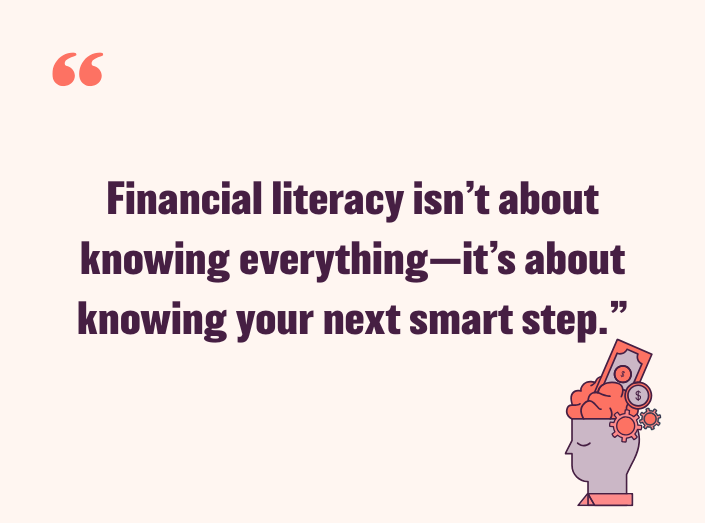Why financial literacy matters in Switzerland right now
Switzerland offers high incomes, strong banks and a reliable social system, yet day-to-day money skills still decide how confident you feel. Prices are high, pension pillars can be confusing, and digital finance moves quickly. Financial literacy is not about becoming an expert. It is about knowing what to do next, using the right tools, and building habits that make life easier. This guide gives you a simple path you can follow at your own pace.

Step 1. Take a snapshot of your money today
Start by listing your net income, fixed costs and flexible spending for one normal month. Fixed costs include rent or mortgage, health insurance premiums, transport pass, childcare, utilities and minimum debt payments. Flexible spending covers groceries, eating out, subscriptions and small treats. Do not aim for perfect detail on day one. You simply need a clear view of what comes in, what goes out and what is left.
Step 2. Build a basic Swiss budget that actually fits your life
Use your snapshot to set realistic limits. Protect essentials first, then set a monthly savings amount before lifestyle spending. In Switzerland, health insurance and transport are significant, so give them proper space in your plan. Leave a small cushion for surprises so the budget does not collapse the first time life gets messy.
Step 3. Open the right accounts for the job
Separate money by purpose. Keep a main current account for bills, a savings account for your emergency buffer and goal pots for short-term plans such as holidays or a new bike. If you do not already have one, open a Pillar 3a for long-term retirement saving. Separation reduces temptation and makes progress visible.

Step 4. Build your emergency fund
Aim for at least one month of essential expenses to start, then grow toward three to six months. Park this in a simple savings account so the money stays liquid and safe. Do not chase high returns here. The purpose is stability.
Step 5. Understand the Swiss pension pillars
Pillar 1 is state pension based on contributions from your salary. Pillar 2 is your occupational pension from your employer. Pillar 3a is your voluntary private pension with tax advantages. Ask your HR for a Pillar 2 statement, check your expected Pillar 1 coverage and open or review your Pillar 3a. Even small regular contributions to Pillar 3a can lower your taxable income and grow over time.
Step 6. Tame debt and protect your credit reputation
List all debts and the interest rates. Prioritise the most expensive first. If you use credit cards, pay the full balance monthly. Set alerts so you never miss payments and keep your utilisation low. Good payment habits protect your rating and keep future borrowing costs down.

Step 7. Learn the tax basics that matter most
Note your canton’s filing deadlines, deductions and allowances. Common Swiss deductions include Pillar 3a contributions, commuting, some insurance premiums and childcare costs. Keep digital copies of receipts and year-end certificates so filing takes hours, not weeks. If your situation is complex, a one-off session with a tax professional can pay for itself.
Step 8. Start investing the simple way
Once your buffer is in place and debt is under control, begin investing for the long term. A straightforward approach is to use low-cost diversified funds, ideally within a Pillar 3a or taxable investment account depending on your goals. Automate monthly contributions, ignore short-term noise and review once or twice a year. Investing is for long horizons, not quick wins.

Step 9. Use Swiss-friendly digital tools wisely
Choose one budgeting or banking app you actually like, connect your accounts and turn on spending insights and payment alerts. Set automatic transfers on payday to savings and investments. Fewer tools used well beat many tools you never open. Technology should remove friction, not create it.
Step 10. Set up your safety nets
Check health insurance franchise level, add accident and liability insurance if needed, and review life or income protection if others rely on your income. Store policy details, account numbers and emergency contacts in one secure place that a trusted person can access if required.
Step 11. Create a review rhythm you can keep
Pick one day each month for a 20 minute check-in. Confirm bills are paid, glance at spending categories, top up goals and note any upcoming costs. Every six months, review your savings rate, insurance and investments. Small regular check-ins beat heroic once-a-year efforts.

Common mistakes to avoid
Do not skip the emergency fund and go straight to investing. Market dips happen and you do not want to sell investments to cover a dentist bill. Do not overcomplicate your toolset. One clear system you use is better than three you ignore. Do not copy a friend’s investment choices without checking fees, risk and time horizon. Your life decides your plan.
A simple 30-60-90 day plan
Days 1 to 30. Do the money snapshot, set a basic budget, open or label accounts, and start your first emergency fund transfer. Gather pension and tax documents in one folder.
Days 31 to 60. Automate savings, open or review Pillar 3a, map all debts and start higher payments on the most expensive one. Turn on bank alerts and check your insurance coverage.
Days 61 to 90. Make your first automated investment, refine spending limits based on real data, and run a short half-year review to confirm what is working and what needs adjusting.

Final thoughts
Financial literacy grows through small wins repeated over time. In Switzerland, where costs are high and choices are many, the basics still carry you the furthest. Know your numbers, separate your money, automate the right things, and review on a simple rhythm. Confidence follows clarity, and clarity comes from action.
Ready to keep learning with simple, practical steps?
Download our app for more info and get easy tools, clear guides and step-by-step support tailored to everyday Swiss money decisions. From budgeting to pensions and first investments, everything you need is in one place.
Discover more
-
How to Build an Ethical Investment Portfolio in Switzerland
Want to invest with purpose? Learn how to build an ethical investment portfolio in Switzerland that aligns with your values and yo... -
Financial Literacy in Switzerland: What It Is and Why It Matters in 2025
Financial literacy in Switzerland is more important than ever. Discover what it means, why it matters in 2025, and how to strength... -
The 4 steps to sustainable investing

